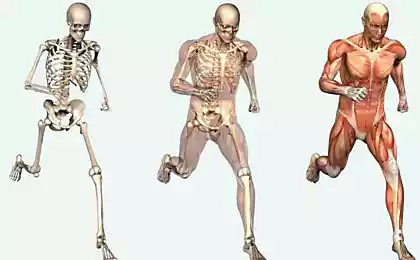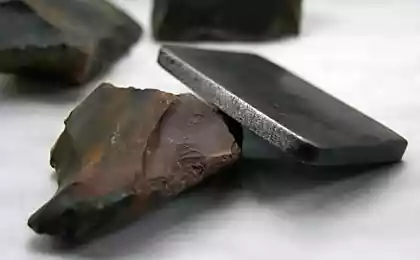805
Residents of the body
Do you regularly brush your teeth and take a bath? Even so, in our body is home to many different microorganisms and fungi, and not very useful. By weight in each of us collected a few kilograms of bacteria, and some of them you will see under the cut
10 ph via mindhobby
Treponema denticola
This nasty bacteria lives in the mouth, but in a healthy body, it is powerless. If you do not follow the oral hygiene, this microbe could harm the gums, multiplying in a secluded spot between the surface of the tooth and gums. This bacterium is a "relative» Treponema pallidum, which causes syphilis to.
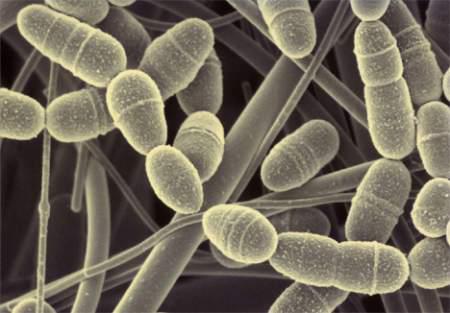
Porphyromonas gingivalis
There is a bad disease - periodontal disease. So the cause of this disease is that it is a microorganism. In addition, it causes an infection, the bacterium also "responsible" for the body's resistance to antibiotics. In advanced cases it displaces useful "tooth" bacteria and settles in their place, causing gum disease and eventually tooth loss.

Veillonella
This bacterium is live not only in the mouth, but also the respiratory and digestive tract of humans. Unlike the previous two it can be called useful, as certain types of slowing down the development of caries, processing acid that destroys tooth enamel, less corrosive compound. However, in the family of bavtery there is a more aggressive species, such as Veillonella alcalescens, are not as useful and cause infectious diseases.
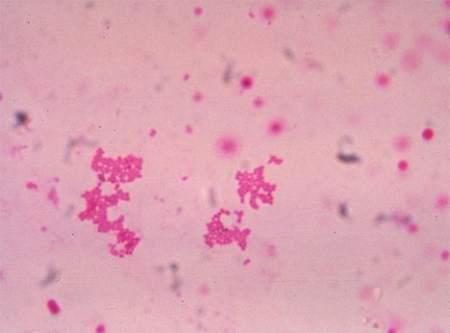
Helicobacter pylori
Gastric juice is known, it is a strong acid and processing all that it misses. But even so, in such an aggressive environment live bacteria of the species Helicobacter pylori, which gradually penetrates the walls of the stomach, causing stomach ulcers and gastrity.dve-thirds of the world's population are infected with this bacterium, but fortunately, most of the infection occurs without any symptoms that is safe.

Bacteroides fragilis
More than 60% of the dry weight of our faeces made up of various fungi and bacteria. Despite their outward signs unappetizing, microorganisms living in the digestive tract are essential to us for a full life. They are sometimes called hidden digestive organs, as without these creatures, we would not be able to digest food and live. Like everywhere else in the world, among these bacteria have beneficial and harmful. The former include, for example, Bacteroides fragilis, which helps us produce vitamin K and inhibits the proliferation of harmful microorganisms. In some cases, the same bacterium can "cooperate" with certain E. coli and cause indigestion and intestinal infections.
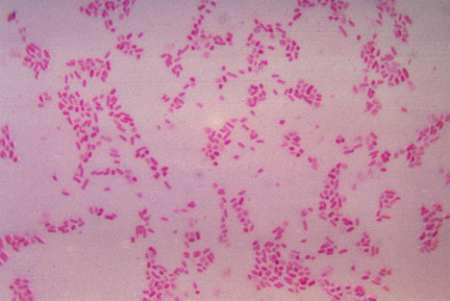
Escherichia coli
The best-known bacterium because of its hazards and risks to our body. To be more precise, that there are many strains of this type of bacteria, some of which are harmful to us, some are useful and necessary. The differences between them are so small that we still do not know how the immune system of our body distinguishes them and manages to neutralize before would suffer significant harm. For example, strain Nissle 1917 not only useful but is used in medicine as a nutrient medium for the cultivation of other beneficial microorganisms. Other strains, especially trapped in our bodies with ill-treated meat and dairy products, can lead to death.

Candida albicans
This fungus is in each of us, and in various places of our body. In healthy people, the immune system keeps a tight rein on him, but when the body is relaxed, begin to develop various diseases. This docile celled bacteria from turning into aggressive multicellular beginning to multiply rapidly in various areas - from the mouth to the lower intestine and genitals. This gives rise to the disease known as thrush layman (or candidiasis). This situation brings great inconvenience and discomfort, but if the immune system is very weak, or if the body has AIDS, is harmless at first glance, thrush can lead to penetration of microbes into the bloodstream, and the defeat of the important internal organs such as the heart.

Malassezia
Another type of fungus, the effect of which is expressed in the discomfort of the scalp (itching, burning). Different types of fungus such as M. globosa and M. restricta, like to settle in the fattest parts of the body, especially in hair, causing dandruff and various dermatitis. In our head can fit up to ten million copies of this fungus. Other types of bacteria, such as M. pachydermatis, normally live on the skin of animals, but rough handling and can fall on the surface of human skin.
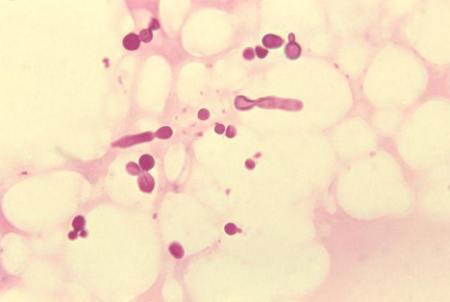
Staphylococcus
In our time, the word "staph" caused consternation among many facing him sick, especially the particular form of the disease that it causes - MRSA (translation - Staphylococcus aureus resistant to penicillin). One species of the microorganism, S. aureus, causes severe disease and is transmitted directly into the blood stream by contact with a damaged surface of the skin of another person. Less dangerous kind, called S. epidermidis also have almost every one of us, but it is usually harmless. In certain cases, if used improperly, medical instruments and it can get into the bloodstream, causing infectious diseases of the blood, eye, and genitourinary tract.

Propionibacterium acnes
Many people think that acne appear on the frequent use of baking chocolate or greasy, but a real cause of acne is a combination of hormones, flakes of dead skin, oil and bacteria. The name of this bacterium - P. acnes. It is not known only on what basis this disease affects certain pores on the surface of the skin without affecting the others ... The above-mentioned bacteria live in fatty acid medium pores, and when the pores are closed plug of sebum, they begin to multiply uncontrollably, causing inflammation and very unsightly damage skin. To fight this bacterium most effectively using benzoyl peroxide and other substances, such as essential oil of clove. For a number of antibiotics, such as tetracycline, the microorganism is insensitive.

Source:
10 ph via mindhobby
Treponema denticola
This nasty bacteria lives in the mouth, but in a healthy body, it is powerless. If you do not follow the oral hygiene, this microbe could harm the gums, multiplying in a secluded spot between the surface of the tooth and gums. This bacterium is a "relative» Treponema pallidum, which causes syphilis to.

Porphyromonas gingivalis
There is a bad disease - periodontal disease. So the cause of this disease is that it is a microorganism. In addition, it causes an infection, the bacterium also "responsible" for the body's resistance to antibiotics. In advanced cases it displaces useful "tooth" bacteria and settles in their place, causing gum disease and eventually tooth loss.

Veillonella
This bacterium is live not only in the mouth, but also the respiratory and digestive tract of humans. Unlike the previous two it can be called useful, as certain types of slowing down the development of caries, processing acid that destroys tooth enamel, less corrosive compound. However, in the family of bavtery there is a more aggressive species, such as Veillonella alcalescens, are not as useful and cause infectious diseases.

Helicobacter pylori
Gastric juice is known, it is a strong acid and processing all that it misses. But even so, in such an aggressive environment live bacteria of the species Helicobacter pylori, which gradually penetrates the walls of the stomach, causing stomach ulcers and gastrity.dve-thirds of the world's population are infected with this bacterium, but fortunately, most of the infection occurs without any symptoms that is safe.

Bacteroides fragilis
More than 60% of the dry weight of our faeces made up of various fungi and bacteria. Despite their outward signs unappetizing, microorganisms living in the digestive tract are essential to us for a full life. They are sometimes called hidden digestive organs, as without these creatures, we would not be able to digest food and live. Like everywhere else in the world, among these bacteria have beneficial and harmful. The former include, for example, Bacteroides fragilis, which helps us produce vitamin K and inhibits the proliferation of harmful microorganisms. In some cases, the same bacterium can "cooperate" with certain E. coli and cause indigestion and intestinal infections.

Escherichia coli
The best-known bacterium because of its hazards and risks to our body. To be more precise, that there are many strains of this type of bacteria, some of which are harmful to us, some are useful and necessary. The differences between them are so small that we still do not know how the immune system of our body distinguishes them and manages to neutralize before would suffer significant harm. For example, strain Nissle 1917 not only useful but is used in medicine as a nutrient medium for the cultivation of other beneficial microorganisms. Other strains, especially trapped in our bodies with ill-treated meat and dairy products, can lead to death.

Candida albicans
This fungus is in each of us, and in various places of our body. In healthy people, the immune system keeps a tight rein on him, but when the body is relaxed, begin to develop various diseases. This docile celled bacteria from turning into aggressive multicellular beginning to multiply rapidly in various areas - from the mouth to the lower intestine and genitals. This gives rise to the disease known as thrush layman (or candidiasis). This situation brings great inconvenience and discomfort, but if the immune system is very weak, or if the body has AIDS, is harmless at first glance, thrush can lead to penetration of microbes into the bloodstream, and the defeat of the important internal organs such as the heart.

Malassezia
Another type of fungus, the effect of which is expressed in the discomfort of the scalp (itching, burning). Different types of fungus such as M. globosa and M. restricta, like to settle in the fattest parts of the body, especially in hair, causing dandruff and various dermatitis. In our head can fit up to ten million copies of this fungus. Other types of bacteria, such as M. pachydermatis, normally live on the skin of animals, but rough handling and can fall on the surface of human skin.

Staphylococcus
In our time, the word "staph" caused consternation among many facing him sick, especially the particular form of the disease that it causes - MRSA (translation - Staphylococcus aureus resistant to penicillin). One species of the microorganism, S. aureus, causes severe disease and is transmitted directly into the blood stream by contact with a damaged surface of the skin of another person. Less dangerous kind, called S. epidermidis also have almost every one of us, but it is usually harmless. In certain cases, if used improperly, medical instruments and it can get into the bloodstream, causing infectious diseases of the blood, eye, and genitourinary tract.

Propionibacterium acnes
Many people think that acne appear on the frequent use of baking chocolate or greasy, but a real cause of acne is a combination of hormones, flakes of dead skin, oil and bacteria. The name of this bacterium - P. acnes. It is not known only on what basis this disease affects certain pores on the surface of the skin without affecting the others ... The above-mentioned bacteria live in fatty acid medium pores, and when the pores are closed plug of sebum, they begin to multiply uncontrollably, causing inflammation and very unsightly damage skin. To fight this bacterium most effectively using benzoyl peroxide and other substances, such as essential oil of clove. For a number of antibiotics, such as tetracycline, the microorganism is insensitive.

Source:





